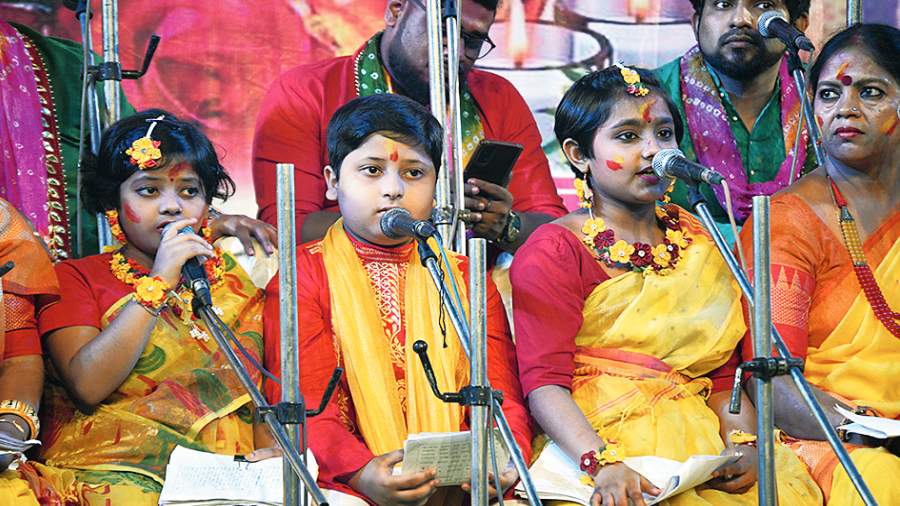AE Block, New Town
The permanent stage in Subhas Chandra Bose Udyan provided an extra reason for celebration as residents of AE Block in New Town organised Basantotsab on Friday evening.
The park, spread over 60,000 sq ft., opened in January 2021 and the spacious stage is built against a boundary wall in its central section. “This is the first time we are performing here,” said Avipsita Basu, who danced to Phaguner Mohonay sung in chorus by block residents. “Earlier, all programmes would be jointly held by AB and AE blocks on a stage erected where the Netaji statue now stands. It would have nails sticking out. Once I cut my foot,” the 16-year-old recalled. “So such fears here.”
The big stage also meant abundance of space for singers, musicians and dancers alike. “We are delighted with this new facility. Of course, we still have to seek permission from NKDA. The only requirement is of a source of electricity. We have put in a request to the authorities for that,” said secretary of New Town AE Block Cultural and Social Welfare Association Sanjoy Sikdar, who had to provide the connection for the lights and the sound system from his house.
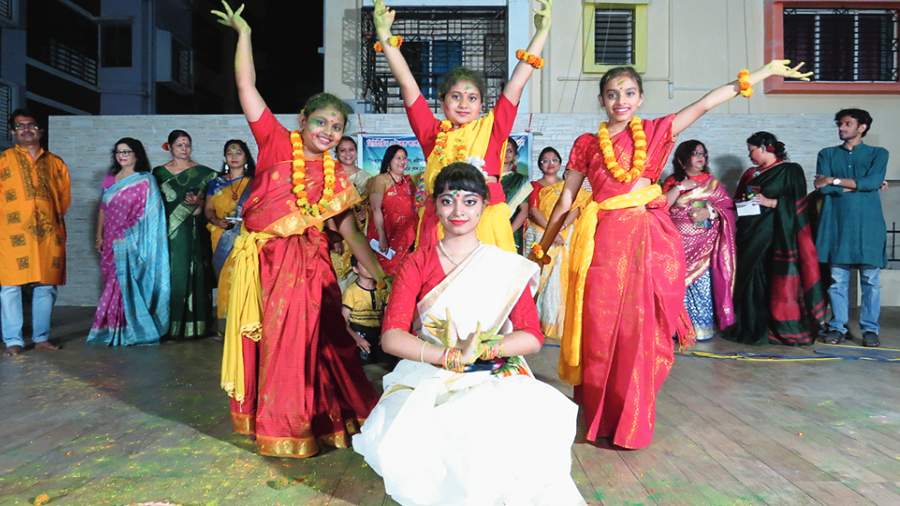
Dancers on stage at the Subhas Chandra Bose Udyan in AE Block. Sudeshna Banerjee
NKDA chairman Debashis Sen and chief executive officer Animesh Bhattacharya attended the programme. “It would be nice if we could hold something centrally for Basanta Utsab. The cultural programme that happens from 7am to 9am at Rabindra Tirtha will continue. After that, the blocks can be given slots to hold their own programmes at the venue. We will do a video conference soon to discuss what can be done. I have also heard that programmes are held the evening before Dol Purnima in Santiniketan. We can think of that here as well,” said Sen, encouraging the block on hearing that they planned to stage a play at the park on Rabindra Jayanti.
The trio of Teesta Banerjee, Debeshi Shome and Sunishka Chanda danced to Phagun haway haway. Sunishka, despite being the youngest at nine years, had choreographed the song for her friends who are a year older. “She has her YouTube channel too, with 27 followers. I put in guest appearance sometimes in her videos,” smiled Debeshi, who had also taken part in the prabhat pheri brought out by the block.
Pritha Banerjee, Teesta’s mother, sang the Nazrulgeeti Kuhelir dolay chore. “Such programmes bring us residents together. Today if I need help at 1.30am, I know I would,” she said.
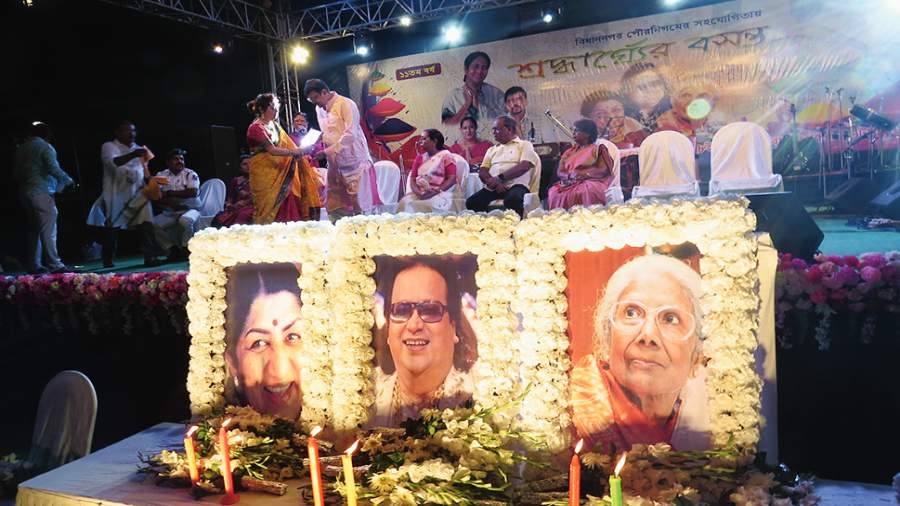
Saswati Sarkar recited a self-composed poem on Radha, in which she pines for Krishna. “When Radha was dying she had asked him to play the flute till her last breath. Krishna did so and then broke his flute, never to play again,” said Sarkar.
The programme was scripted by Rajeshwari Banerjee with songs and poems of the season.
“We used to hold a small cultural programme after prabhat pheri but participation was minimal as people would get tired in the heat after walking and leave. So this year we shifted the programme to the evening,” said assistant secretary Debmalya Shome.
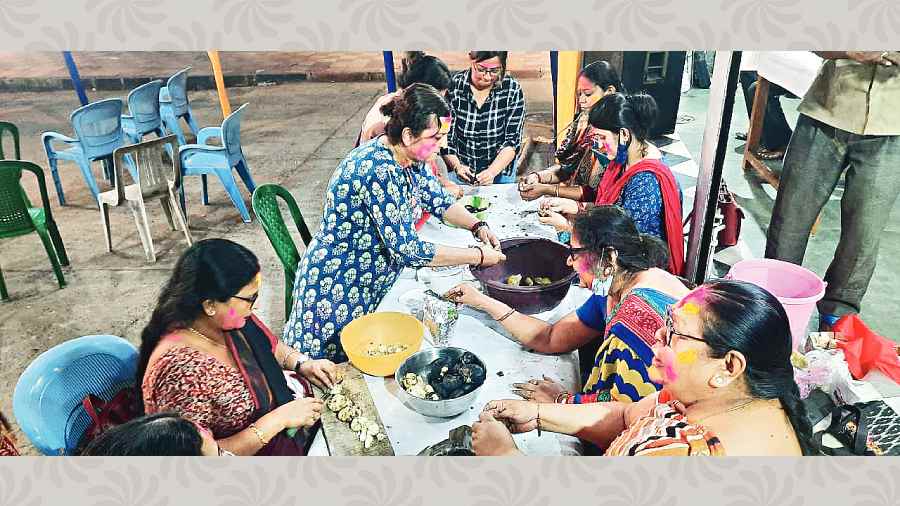
AE Block (Part 2)
“Our only expense in doing nyara pora is kerosene and potatoes,” joked secretary of AE (Part 2) Tapas Sengupta. The committee has been organising the burning ritual for some 15 years now and as much as residents await the fire, they also await the “prasad” of potatoes that are roasted in it. “The wood for the pyre we simply pick up from wherever we see branches lying about. It doesn’t have to be purchased,” said Gulli Das, the security guard at the community hall. But it was his job to diligently go and buy 10kg of potatoes from AE Market, outside which the fire was lit.
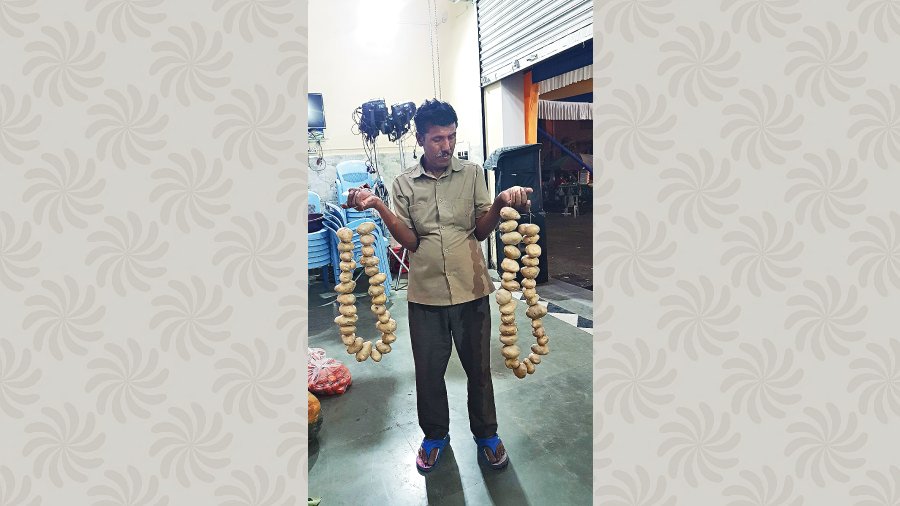
Garlands of potatoes ready to be roasted
“We make garlands of the potatoes and shove them in the pyre when the flames are dying. We use sticks to pull them out and check if they are ready to be eaten,” said Anita Saha, a resident who awaits this day every year to relish the potatoes and also help roast them. They then dunk the potatoes in water to cool them down and lay them out on the table. Ladies of the block spread out and peel the potatoes, chop them to bits and apply salt, lemon, chillies and coriander to them. “Of course, this isn’t written in the scriptures but to us, this is like prasad after the nyara pora.
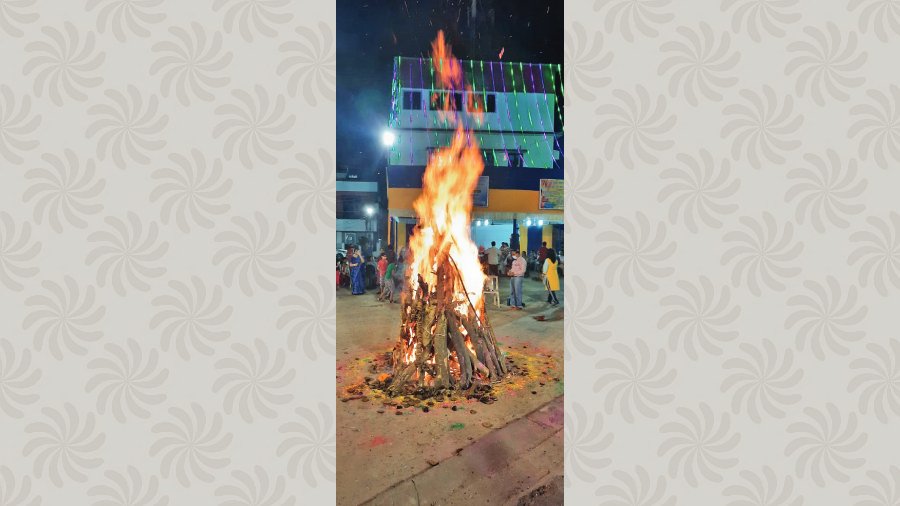
Nyara pora in front of AE Market
We serve them to whoever is around in shaal leaf bowls,” said Saha. Sengupta says the ritual had started years ago with a couple of potatoes by individuals. “But soon it gained popularity and we decided to play it up since it increases participation from residents,” he said. The block also held a Holika dahan a few hours later the same night. “While one can be lenient with nyara pora, Holika is a puja that requires a priest and must be performed at a particular time as mentioned in the almanac.” This year it was burnt after midnight.
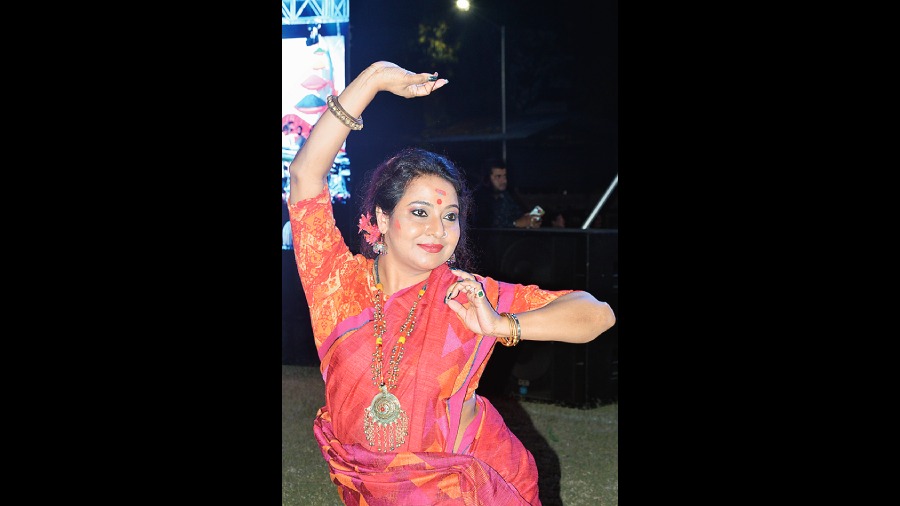
Smriti Sengupta Pathagar, FD Park
An evening of tribute was presented at FD Park on Friday evening as Smriti Sengupta Pathagar, in collaboration with Bidhannagar Municipal Corporation, hosted a programme in memory of three recently departed music legends, Lata Mangeshkar, Sandhya Mukhopadhyay and Bappi Lahiri.
“Sandhya Mukhopadhyay is Bengal’s pride. Lataji I had the chance to speak to once over phone, thanks to Asha (Bhosle)ji. I knew Bappida well. I accompanied his family members when they came to Calcutta to immerse his ashes in the river. Artistes and music directors of their calibre will not be born again,” said fire and emergency services minister and local MLA Sujit Bose.
The programme started with the garlanding of portraits of the three by Bose, mayor Krishna Chakraborty and deputy mayor Anita Mondal.
After solo shows by artistes specialising in songs of each icon, Supriya Barik, Molly Chandra and D. Arun, it was the turn of group initiatives of various music and dance schools, under the umbrella of the BD Block-based organisation Khola Hawa.
“We are a fixture for Dol at FD Park for 12 years now. In 2020, the lockdown was announced within a few days of our programme. And last year, by the time we held the programme here after a few other pre-Holi shows, most of us were down with Covid. Just five of us could take stage,” said Sanjukta Das of CJ Block. “It spread from our rehearsals,” recalled Debjani Mallik of BD Block.
The Khola Hawa singers started their segment with their signature opening — the Tagore song Tomar khola hawa, from which they derive their name. This is the first time that they were fielding children to sing on their own. Suranjali Chakraborty, 9, had performed earlier on stage but admitted to being a little nervous. The Bidhan Sishu Udyan music student sang Shob dibi ke with brother Suradip, 12, and Siyona Raha, 9, of BD Block to a lot of applause.
All the performers were delighted to get back on stage. “We used to have online dance classes. But it was no fun. Sometimes the phone, which would be kept inclined on the table, would keel over while I was showing my dance to our teacher,” recalled Ayanna Patra, of Payel Dance Academy, who performed with her friend and Sech Abasan neighbour Ayati Chatterjee, along with others.
Despite the large number of participants, organiser Pradip Sengupta ensured that the programme ended by 10pm, the cut-off time. “Higher secondary exams are coming. I did not want to bother examinees,” he said.
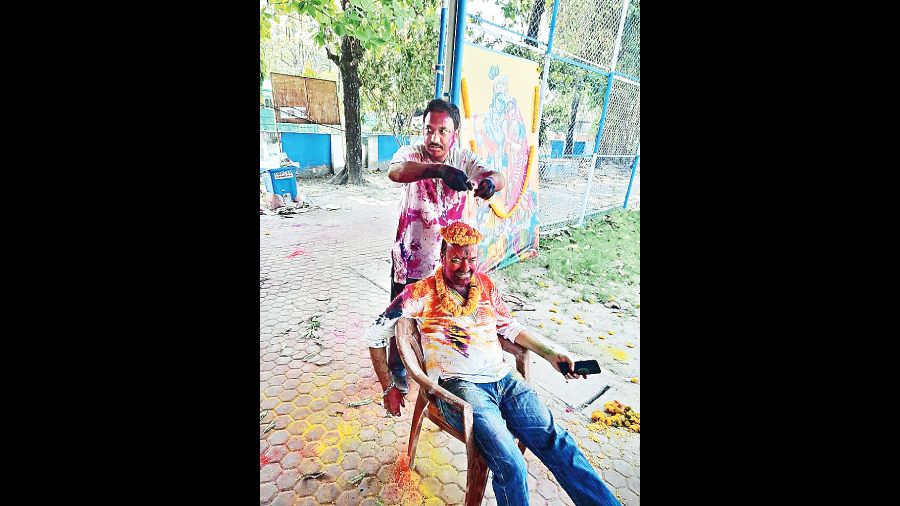
CK-CL Block
More than 30 residents of CK-CL Block began March 18 with a Doljatra procession. The ladies dressed in yellow-and-red saris, the men in white kurtas. “We covered every lane of the twin blocks, dancing and singing songs of the spring. We found many residents greeting us from balconies and got to perform pranam on the elderly residents who came out,” said Shanti Ranjan Paul, secretary of Bidhannagar CK-CL Block Residents’ Association. Thereafter residents congregated in the park, watched dances by folk performers and played their hearts out.
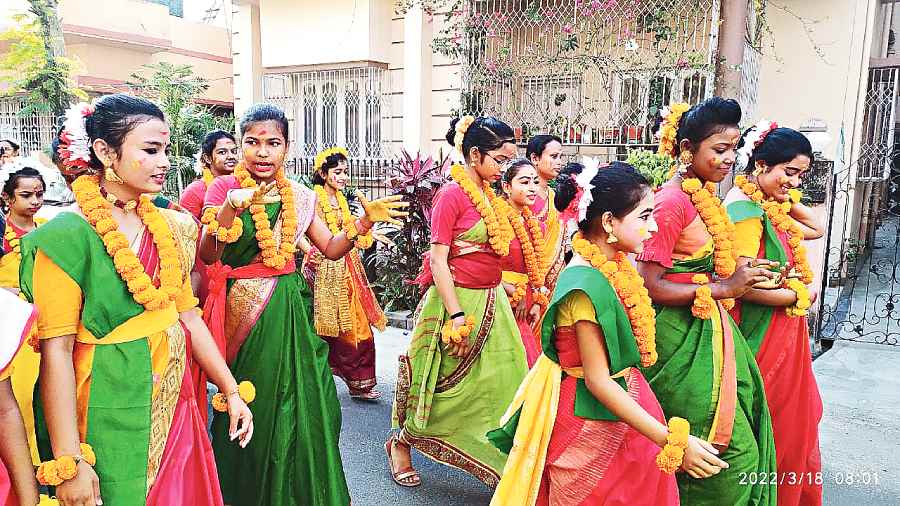
BD Block
Girls of BD Block during their probhat pheri on the morning of Holi. They performed dances after the walk too. Councillor Ratna Bhaumik joined them for the procession

Nyara pora in progress in BA Block
BA Block
For BA Block, it was an extended weekend of fun, festival and music. It began with nyara pora on the eve of Holi, followed by a procession in the morning and play with colours. Women presented a cultural show too.
“Since the Covid count is low now and people aren’t afraid of stepping out, we also decided to hold our annual get-together last weekend. This had been pending since January,” said block president Arunava Das. So they invited the likes of Pousali Banerjee of Zee Bangla Sa Re Ga Ma Pa fame and veteran guitarist Swapan Sen to perform. “We also felicitated Sen who has worked with legends like Lata Mangeskar, Kishore Kumar, RD Burman, Satyajit Ray and Bappi Lahiri,” said Das.
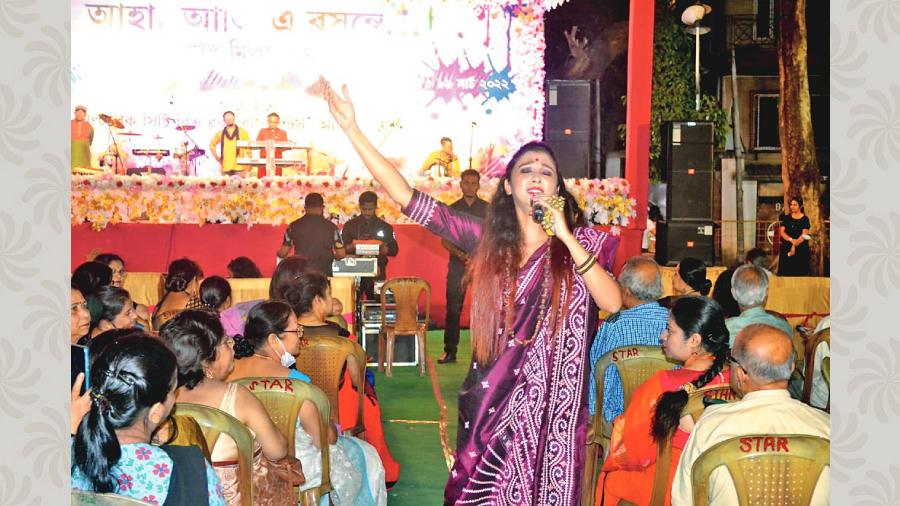
Pousali Banerjee on song
Sen played some songs he has been part of, such as Chura lia hai and Lekar hum deewana dil. Singer Sivaji Chatterjee, also a resident of the block, felicitated Sen, a Hatibagan resident, who is nearly 80 years of age.
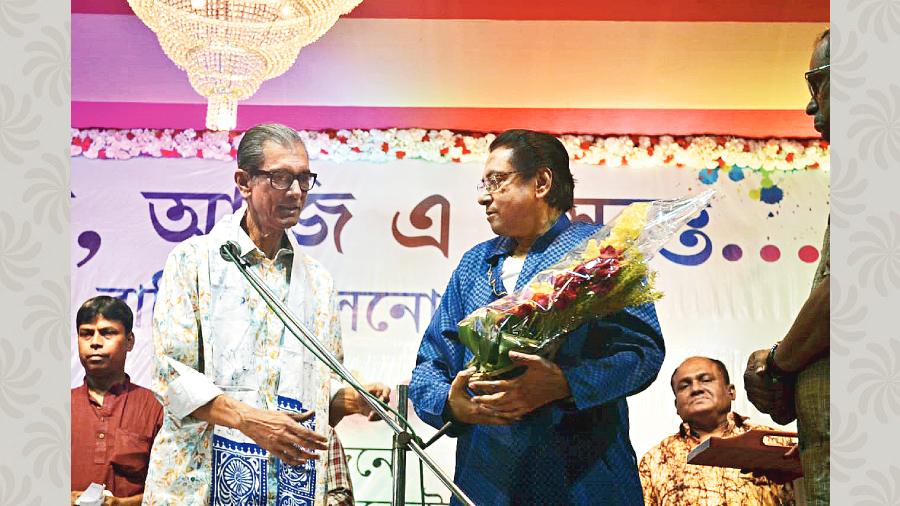
Sivaji Chatterjee offers a bouquet of flowers to veteran guitarist Swapan Sen
“Actor Rajatava Dutta, a block resident, and Upal of the music band Chandrabindu, who is a jamai of BA Block, joined us too,” said Das. Upal also sang a folk number.
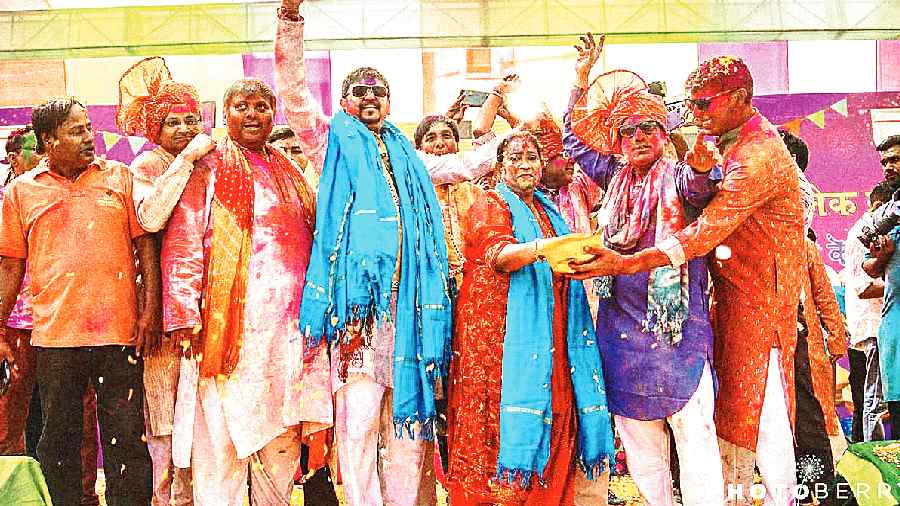
Salt Lake Sanskritik Sansad
BF Park was a riot of colours on Holi. More than 10,000 had gathered for the celebration by Salt Lake Sanskritik Sansad that included games, music and food. MLA and minister Sujit Bose and mayor Krishna Chakraborty attended the occasion too (picture right). “Everyone praised our arrangements this year and we are glad we could pull it off despite the challenges of the pandemic,” said convenor Sanjay Poddar.
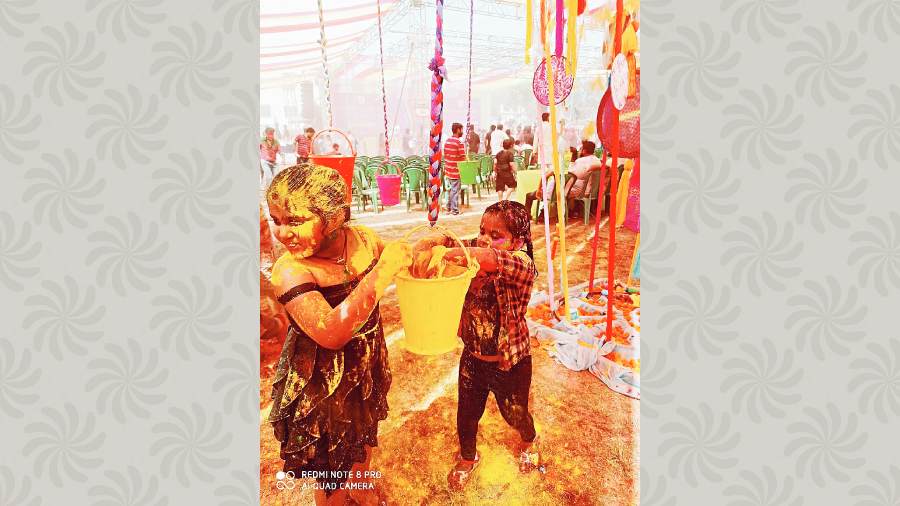
There were pools of coloured water, bouncy castles, buckets of water hanging from the scaffolding and more. “A new attraction was a 360° camera. Revelers stood on a podium and danced or made merry while a camera circled them, shooting a video from all sides.”

Eastern High, New Town
Residents of Eastern High not only jumped into their pool for a colourful splash but they also performed puja. “Senior citizens had been asking us to start a Radha-Krishna puja on this occasion and we began the tradition from last year,” said Rajashik Kar, president of the cultural sub-committee.
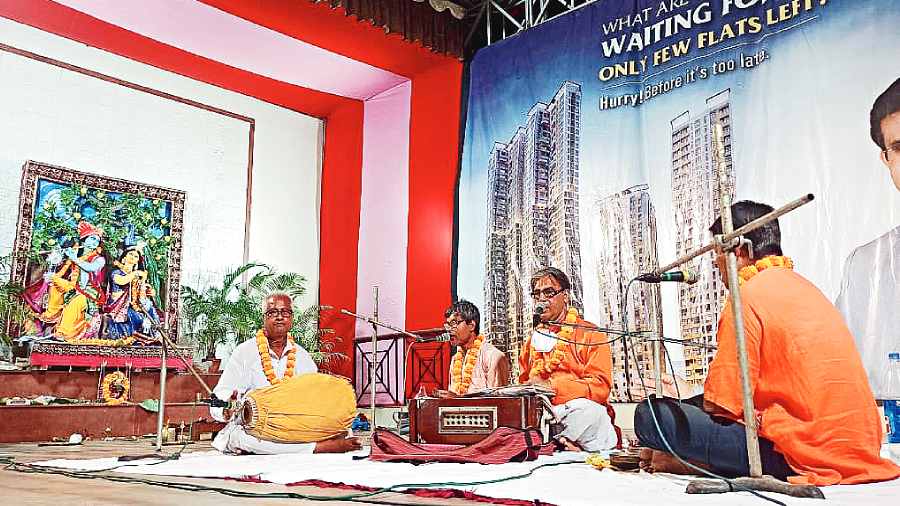
Guest artistes on song at Eastern High. (Right)
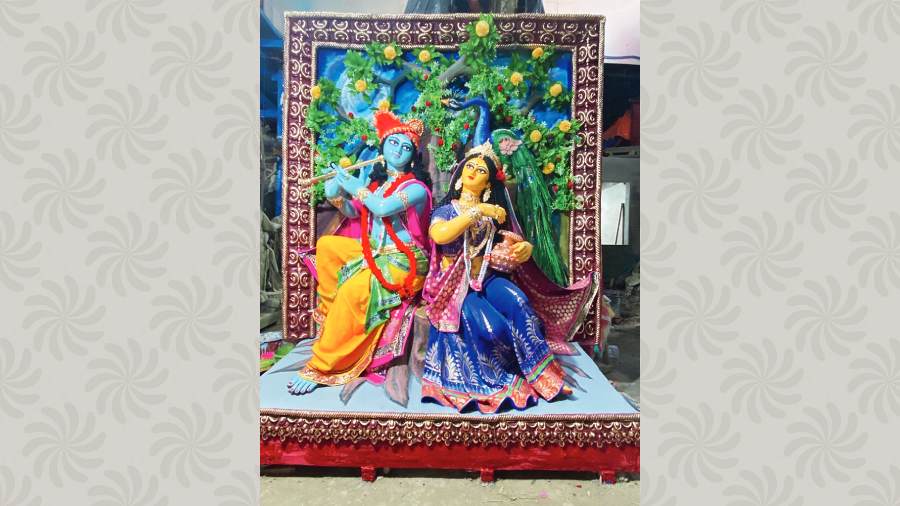
The Radha Krishna idol created by Sanatan Rudra Pal
Their idol was sculpted by Sanatan Rudra Pal. There was also a fair where women sold home-made food, residents performed cultural programmes and guest musicians sang bhajan, kirtan and folk numbers.
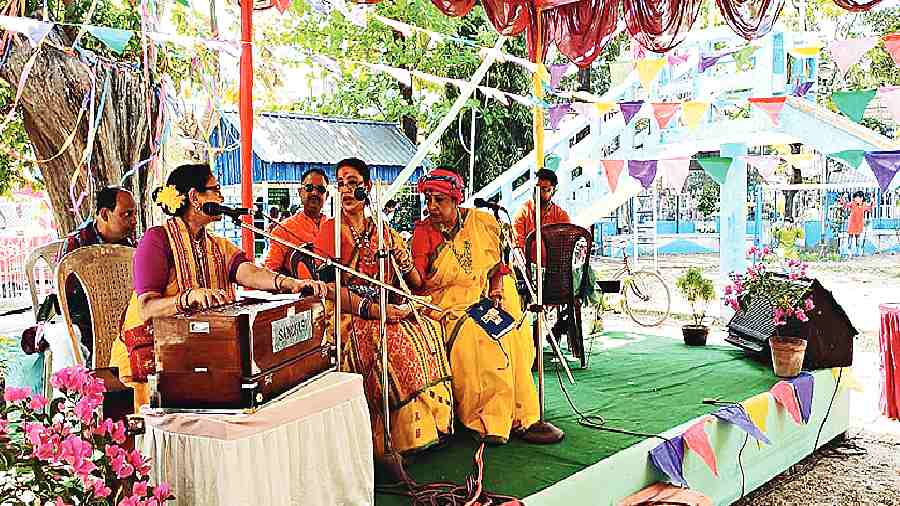
AJ Block
A good number of residents turned up for a baul music show at AJ Block. “We decided to hold the event in the open to absorb the feel of the festival and built a shade overhead to protect us from the heat,” said Lalan Saha, one of the cultural convenors of AJ Block. “We erected the stage around a large tree in the park for that Santiniketan feel.” While residents did not play Holi together they all came to dance to a medley of folk songs by the baul group as their final presentation.
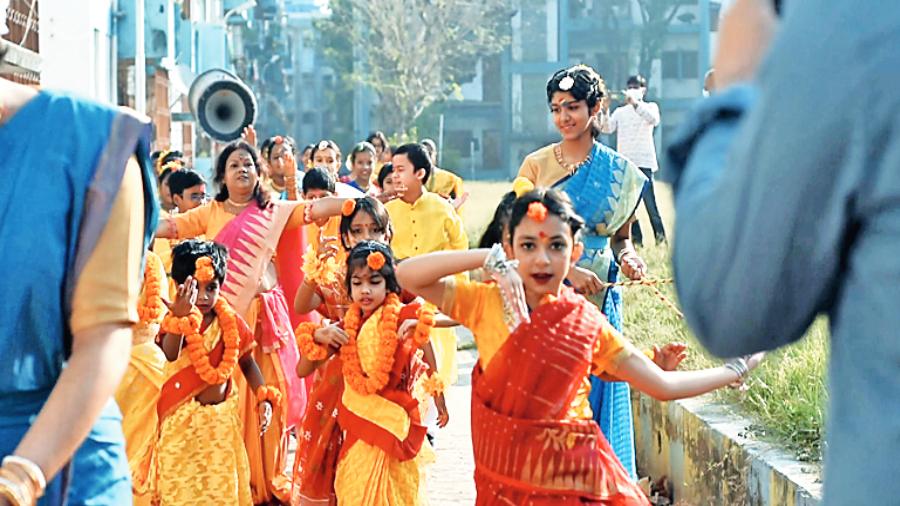
Children at the head of the prabhat pheri at Falguni Abasan
After two long years of being restricted from social gatherings, Falguni Abasan experienced a Santiniketan-style Basanta Utsav last Friday on Dol Purnima. This was the first time that the occasion was celebrated formally in the housing complex. Till now, all that happened on the day was play with colours among kids.
“We enjoy organising cultural programmes round the year. But everything was cancelled these last two years. We were missing our previous way of life. So we thought of holding this programme for the first time to refresh our soul,” cultural secretary of Falguni Abasan Jhuma Paul — Jhuma aunty to all of us youngsters — said.
With my Class XII Boards barely a few weeks away, I had initially decided not to participate. But when I saw my friends rehearsing for the programme, I could not resist myself and joined them.
On Friday, all of us gathered at the Falguni Abasan playground around 7.30am for our prabhat pheri. We were dressed in saris and floral ornaments of contrasting colours. The boys wore yellow kurtas.
We walked around our complex, dancing to the song Ore grihobashi. As the mercury level was quite high, everyone was sweating profusely, but it could not dent our excitement, especially of the children who were engrossed in singing and dancing. The youngest participant was two-year-old Bihu who had wailed on seeing her sister and mother dress up and leave home, forcing them to bring her along. The munchkin, wearing a new yellow frock, was so overjoyed that she also started moving her little hands to the beat of the song with us. “She is not interested in staying in my lap,” her mother Debolina Halder laughed.
After 45 minutes, the prabhat pheri concluded at the foot of the stage around 8.30am and the second part of our programme started. Our choreographer, Jhuma aunty, had decorated the stage beforehand with plants and abir. We performed several dance items to songs sung by our resident singers, like Aji dokhin duar khola, Fagun haway haway and Jhoro jhoro jhore ronger jhorna. Some poems were also recited.
The programme was followed by abir khela. Soon, our WhatsApp groups were flooded with pictures of the day. Now everyone wants Basanta Utsav to become an annual affair.
— Sanchari Chakraborty, Falguni Abasan
